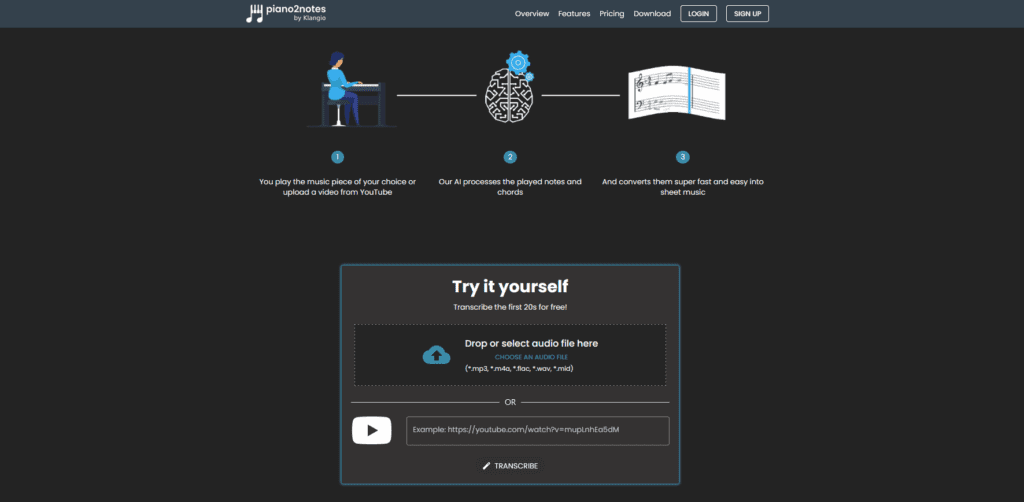Transcribing music by ear is a valuable skill for musicians, but it requires strong aural skills. Ear training is essential for developing accurate transcription abilities. This article will explain what music transcription involves, why ear training is vital for transcription, provide tips for ear training exercises, and outline the many benefits to transcribe music this way.
Defining Music Transcription and Its Elements

Music transcription is the process of notating the elements of a recording by listening attentively. Transcriptions should precisely represent the:
- Melodic pitches and intervals
- Rhythmic patterns and subdivisions
- Time signatures, tempos, and expressive markings
- Chord progressions and harmonic structure
- Instrumentation and vocal parts
Learning to transcribe develops core musical competencies like active listening, music theory knowledge, identifying intervals, understanding rhythm, and recognizing instruments. It’s an invaluable exercise for performers, composers, arrangers, and students seeking to strengthen their musical skills.
The Critical Role of Ear Training for Accurate Transcription
Ear training focuses on honing the aural skills needed to correctly identify musical components solely by ear. This auditory acuity is the foundation for precise transcription. Ear training enables you to:
- Rapidly identify intervals, chords, and chord changes
- Isolate and notate melodies and basslines
- Understand rhythmic groupings and subdivisions
- Detect articulations, dynamics, and other expressive details
- Identify instruments, vocal ranges, and tone colors
- Hear harmonic progressions, cadences and modulations
Without ear training, transcription attempts will be frustrating and imprecise. Ear training bridges the gap between listening and notation by linking aural input to theoretical knowledge.
Using AI to Get Kick-Started

To ease up the frustrating process of starting to transcribe by ear, you could find the Apps from Klangio to transcribe your music automatically useful. Try out the demo transcriptions for free and as often as you like, to check your transcription by ear or to lay down a basis for refinement:
- Piano2Notes to transcribe piano
- Guitar2Tabs to transcribe acoustic, electric and bass guitars
- Sing2Notes to transcribe singing
- Drum2Notes to transcribe drums
Useful Ear Training Exercises and Tips

Here are effective exercises and practice techniques for developing transcription-ready ear training skills:
Interval Recognition Exercises
- Identify isolated intervals like 3rds, tritones, and 6ths
- Transcribe short melodies focusing only on intervallic relationships
- Use online ear trainers for interval recognition practice
Rhythm Reading Drills
- Subdivide beat groupings while tapping along to rhythmic examples
- Transcribe rhythms using claps before adding pitches
- Slow down recordings to better hear subdivisions and syncopations. Any DAW can help you edit audio easily.
Another fun exercise can be playing rhythm games like Beat the Beat – Rhythm Paradise
Melodic Dictation Tips
- Transcribe short diatonic melodies within your instrument’s range
- Listen for melodic contour, direction, and intervals between notes
- Start simple before adding more complex chromatic notes
Chord Recognition Practice
- Identify major, minor, diminished and augmented triads by ear
- Learn to quickly recognize 7th chords and chord extensions
- Identify chord progressions and cadences in songs
Instrument Recognition Games
- Memorize instrument timbres and ranges through listening quizzes
- Isolate individual instruments in transcriptions
- Focus on piano, guitar, bass, drums, winds, brass, and strings
With audio separation, you can double-check the process you’ve made. Learn more about the available tools in this video:
Musical Memory Exercises
- Memorize short melodies, phrases, chord changes, and basslines
- Notice repeating and contrasting elements throughout pieces
Full Piece Transcription
- Start with simple, short excerpts with clear textures
- Slowly build up to longer and more advanced selections
- Verify accuracy against scores or lead sheets
With regular ear training, your transcription skills will improve dramatically. Be patient, consistent, and creative in your practice.
The Multifaceted Benefits of Music Transcription
Now that you understand the vital role of ear training for unlocking transcription skills, let’s examine the many benefits:
- Develops overall musicality and listening abilities
- Internalizes melodic, harmonic, and rhythmic concepts
- Reinforces understanding of music theory and notation
- Provides insight into compositional techniques
- Trains musical memory and internal recall
- Allows micro-level analysis of phrasing and expression
- Reveals inner parts not obvious from casual listening
- Prepares arrangers and composers to write and orchestrate
- Builds repertoire familiarity and musicianship for performers
Though demanding, transcription augmented by ear training offers multifaceted rewards. Whether you’re transcribing jazz, classical, or your favorite songs, ear training is the key to accurate notation and unlocking the secrets of the music.
Conclusion
Targeted ear training forms the foundation for proficient music transcription skills. These ear training tips to transcribe music will bridge the gap between hearing and notating by developing the musical recognition skills needed to accurately notate what you hear. Regular short practice sessions with focused exercises will significantly improve transcription accuracy. Music transcription supplemented by ear training provides wide-ranging benefits for all musicians looking to boost their abilities. Don’t hesitate to use state-of-the-art technology to help you proceed on your journey more easily.

